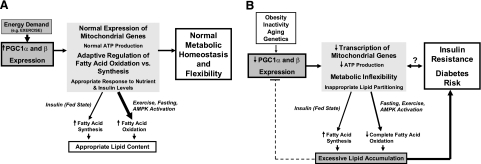Figure 7.
Proposed model of role of PGC-1 in lipid metabolism. Our results suggest that PGC-1 is a critical modulator of lipid metabolism, content, and composition, which regulates appropriate lipid content to ensure adequate ATP production and sufficient fuel availability for energy-requiring states (e.g., exercise). A) With exercise, PGC-1 mRNA and protein expression are increased, resulting in increased expression of genes involved in both mitochondrial biogenesis and lipid metabolism. Expression of genes favoring fatty acid oxidation is dominant in this setting; in contrast, in the fed state, fatty acid synthesis may be dominant, promoting storage of lipid for subsequent bouts of exercise. B) Reductions in PGC-1 expression or function, caused by obesity, chronic inactivity, aging, or genetic predisposition, may contribute to a vicious cycle, promoting impairment of both mitochondrial oxidative function and lipid utilization, leading to reductions in capacity for complete oxidation of lipids and inappropriate lipid accumulation. In turn, sustained lipid accumulation may further reduce PGC-1 expression, perpetuating a vicious cycle of reduced oxidative capacity associated with both insulin resistance and diabetes.

